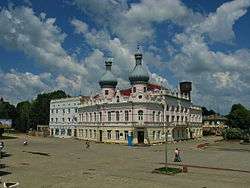Borshchiv
| Borshchiv Борщів | ||
|---|---|---|
|
Old town in Borshchiv | ||
| ||
| Country |
| |
| Oblast |
| |
| Raion | Borshchiv Raion | |
| First mention | 1456 | |
| Magdeburg Rights | 1629 | |
| Population (2001 census) | ||
| • Total | 11,382 | |
| Time zone | EET (UTC+2) | |
| • Summer (DST) | EEST (UTC+3) | |

Borshchiv (Ukrainian: Борщів, Russian: Борщёв, Polish: Borszczów) is a city in the Ternopil Oblast (province) of western Ukraine. It is the administrative center of the Borshchiv Raion (district) and is located at around 48°48′10″N 26°2′11″E / 48.80278°N 26.03639°ECoordinates: 48°48′10″N 26°2′11″E / 48.80278°N 26.03639°E. City population is 11,382 (2001).
Borshchiv has been mentioned under its name as the Dudinski family manor since 1456. In 1629 the town, which at that time belonged to the Kingdom of Poland was granted a Magdeburg charter, and the coat of arms, which was the symbol of the House of Vasa. In 1672–1683 the town was controlled by Ottoman Turks (see Polish–Ottoman War (1672–76)). After the First Partition of Poland (1772), the town was annexed by the Habsburg Empire. In 1809–1815 it was controlled by the Russian Empire and then returned to Austrians. In 1914–1917 it was taken over by the Russian troops again, see Russian occupation of Eastern Galicia, 1914–15. From 1919 to September 1939 it belonged to Poland, and due to proximity of the Polish-Soviet border, a Border Protection Corps Battalion Borszczow was stationed here. In the Second Polish Republic, Borszczow was the seat of a county (powiat) in Tarnopol Voivodeship.
Following the Soviet invasion of Poland in September 1939, the town was annexed by the Soviet Union. It was also occupied by the Hungarian army from July to August 1941. During World War II, several mass executions of Jews were carried out in the town. In April 1942 a Borshchiv Jewish ghetto was established here. Between spring and summer of 1943, approximately 400 Jews were sent to the Ivanovka camp and more than 2,300 Jews were shot in the Jewish cemetery.[1] After a short period of rule by the Germans at the beginning of World War II it was ceded back to the Russians until the fall of the USSR and declaration of Ukrainian independence.
The Borshov Horizon or Borshovian Horizon is a geological layer of marl and limestone formed in the lowermost Devonian period.[2] Typical specimens of this province have been recorded in the Upper Dniester valleys near Borshchiv where it reaches the surface layers of the land. It is marked by the presence of microscopic Margachitina chitinozoans,[2] certain trilobites and bryozoa dispersed in grainstone. According to Pushkin, waterborne Bryozoa living in shallow lagoons were the dominant life form that shaped the Borschovian plains. Some areas of the Borschovian layer were dominated by colonies of a single species where others were populated by a mix of different Bryozoa.[3]
People
- Polish Army General Bolesław Bronisław Duch, born here in 1885
External links
References
- ↑ "Yahad-In Unum Interactive Map". Execution Sites of Jewish Victims Investigated by Yahad-In Unum. Retrieved 23 January 2015.
- 1 2 Traverse, Alfred (2008). Paleopalynology. Volume 28 of Topics in geobiology.. Springer. ISBN 1-4020-6684-8. p. 182.
- ↑ Pushkin, V. I. (1996, in Russian). Mshankovye biogermy i zarosli rannego devona (Мшанковые биогермы и заросли раннего девона) Archived July 6, 2011, at the Wayback Machine.. Litosfera. 1996, no. 4, pp. 62-73.

